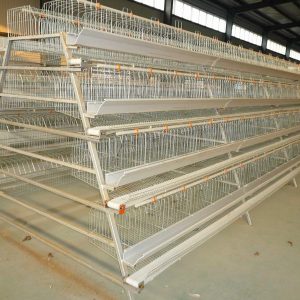poultry cage.Selected fine varieties of “native chicken”
Excellent breeds are the basis for raising high-quality broilers. You should choose the famous local breeds with thin skin, thin bones, full muscles, delicious meat, strong stress resistance, small and medium-sized colored feathers, which can be three yellow chickens or twist green-footed chickens, such as palace yellow chicken, Henan Gushi chicken, Guangxi The fine varieties of Sanhuang chicken and Zhejiang Xianju chicken can also be selected and bred according to local breeding habits and market demand.
Ensure the environmental temperature and humidity of brooding
The key to brooding is to give the chicks a suitable temperature. Take the temperature under the brooder as an example: 1-2 days old is 34℃~35℃; 3-7 days old is 32℃~34℃; 2nd week is 28℃~30℃; 3rd week is 26℃~ 28°C. The brooding temperature drops 2 degrees per week in winter and spring, and 3 degrees per week in summer and autumn, until it reaches 21 degrees. The relative humidity requirements of the chicks are 70% to 75% in the first week, down to 60% in the second week, and try to keep it at a level of 55% to 60% after the third week.
Do stocking safety
After enclosure, the chicks generally weigh more than 0.3 kg and are ready for stocking. At this time, they can be scattered in the woods, reservoirs, and meadows. The chicks catch insects and eat grass seeds in the vast fields. Tender grass, free movement. This period lasts as long as 15 weeks, and the feeding can be gradually reduced from 5 times to 2 times in the hospital. When feeding twice a day, feed less in the morning when it is released, and feed more when it comes back in the evening. During the stocking process, safety precautions must be taken to prevent hazards from natural enemies. The following methods can be used to prevent natural enemies: train dogs to expel nearby rodents and ferrets, use firecrackers to expel eagles, and use nylon nets to cover the pasture.
Feeding specific feed
Part of it is artificial feed. The feed for ecological chickens must be organic feed. For this reason, when planting ecological chicken feed and feed ingredients, it must be cultivated in accordance with organic food requirements. Artificial supplementary animal feed must also be implemented in accordance with the standards for organic food production. In the artificial feed production process, it is strictly forbidden to add various chemicals to ensure the quality of ecological chickens. The other part is natural feed. The quality of natural feed depends on the natural environment, mainly including natural forage, mature seeds and various natural insects. Only with sufficient natural feed and comprehensive nutrition for ecological chickens can high-quality products with high nutrition and strong nourishment be produced.

